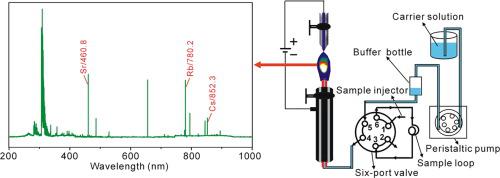当前位置:
X-MOL 学术
›
Microchem. J.
›
论文详情
Our official English website, www.x-mol.net, welcomes your feedback! (Note: you will need to create a separate account there.)
Evaluation of a sampling system coupled to liquid cathode glow discharge for the determination of rubidium, cesium and strontium in water samples
Microchemical Journal ( IF 4.8 ) Pub Date : 2020-11-01 , DOI: 10.1016/j.microc.2020.105246 Quanfang Lu , Hui Luo , Jie Yu , Yuejing Kang , Zhuanhong Lu , Juanlong Li , Wu Yang
Microchemical Journal ( IF 4.8 ) Pub Date : 2020-11-01 , DOI: 10.1016/j.microc.2020.105246 Quanfang Lu , Hui Luo , Jie Yu , Yuejing Kang , Zhuanhong Lu , Juanlong Li , Wu Yang

|
Abstract A simple sample introduction system has been successfully developed, and then integrated with liquid cathode glow discharge (LCGD) to form atomic emission spectrometry (AES) for the detection of rubidium (Rb), cesium (Cs) and strontium (Sr) in water samples by using a fiber-optic spectrometer, in which a buffer bottle was employed to improve the stability of microplasma, and a six-port valve equipped with sample loop was used to reduce the sample consumption and enhance the analytical precision and speed. The effects of flow rate, discharge voltage, supporting electrolyte and solution pH on signal intensity were examined systemically. The matrix interferences of major cations and anions in aqueous solution were also evaluated. The results indicated that the optimal operating conditions are 2.4 mL min−1 flow rate, 660 V discharge voltage and pH = 1.0 HNO3 as supporting electrolyte. Only Al3+ ions interfere with the determination of Rb, Cs and Sr. The limits of detection (LODs) of Rb, Cs and Sr are 0.18, 0.17 and 0.21 mg L−1, respectively, which are basically inferior to those of the closed-type electrolyte cathode atmospheric discharge (ELCAD). The relative standard deviation (RSD) is 2.7% for Rb, 2.0% for Cs and 2.5% for Sr, the correlation coefficients (R2) of Rb, Cs and Sr are over 0.999, and the power is below 50 W. The measured results of Rb, Cs and Sr are in agreement well with the spiked values, and the satisfactory recoveries of standard addition are obtained between 97 and 111%. The advantages of small size, low sample and power consumption and high stability suggested that the LCGD-AES is a promising technique for the detection of Rb, Cs and Sr in water samples.
中文翻译:

用于测定水样中铷、铯和锶的液体阴极辉光放电耦合采样系统的评价
摘要 成功开发了一种简单的进样系统,然后与液体阴极辉光放电(LCGD)结合形成原子发射光谱法(AES),用于检测水中的铷(Rb)、铯(Cs)和锶(Sr)。采用光纤光谱仪,采用缓冲瓶提高微等离子体稳定性,采用带进样环的六通阀减少样品消耗,提高分析精度和速度。系统研究了流速、放电电压、支持电解质和溶液 pH 值对信号强度的影响。还评估了水溶液中主要阳离子和阴离子的基质干扰。结果表明,最佳操作条件为 2.4 mL min-1 流速,660 V 放电电压和 pH = 1.0 HNO3 作为支持电解质。只有 Al3+ 离子干扰 Rb、Cs 和 Sr 的测定。Rb、Cs 和 Sr 的检出限(LODs)分别为 0.18、0.17 和 0.21 mg L-1,基本低于封闭-型电解液阴极大气放电 (ELCAD)。Rb 的相对标准偏差 (RSD) 为 2.7%,Cs 为 2.0%,Sr 为 2.5%,Rb、Cs 和 Sr 的相关系数 (R2) 大于 0.999,功率低于 50 W。 测量结果Rb、Cs 和 Sr 的浓度与加标值一致,标准添加的回收率在 97% 到 111% 之间获得了令人满意的回收率。LCGD-AES 具有体积小、样本和功耗低、稳定性高的优点,是一种很有前途的 Rb 检测技术,
更新日期:2020-11-01
中文翻译:

用于测定水样中铷、铯和锶的液体阴极辉光放电耦合采样系统的评价
摘要 成功开发了一种简单的进样系统,然后与液体阴极辉光放电(LCGD)结合形成原子发射光谱法(AES),用于检测水中的铷(Rb)、铯(Cs)和锶(Sr)。采用光纤光谱仪,采用缓冲瓶提高微等离子体稳定性,采用带进样环的六通阀减少样品消耗,提高分析精度和速度。系统研究了流速、放电电压、支持电解质和溶液 pH 值对信号强度的影响。还评估了水溶液中主要阳离子和阴离子的基质干扰。结果表明,最佳操作条件为 2.4 mL min-1 流速,660 V 放电电压和 pH = 1.0 HNO3 作为支持电解质。只有 Al3+ 离子干扰 Rb、Cs 和 Sr 的测定。Rb、Cs 和 Sr 的检出限(LODs)分别为 0.18、0.17 和 0.21 mg L-1,基本低于封闭-型电解液阴极大气放电 (ELCAD)。Rb 的相对标准偏差 (RSD) 为 2.7%,Cs 为 2.0%,Sr 为 2.5%,Rb、Cs 和 Sr 的相关系数 (R2) 大于 0.999,功率低于 50 W。 测量结果Rb、Cs 和 Sr 的浓度与加标值一致,标准添加的回收率在 97% 到 111% 之间获得了令人满意的回收率。LCGD-AES 具有体积小、样本和功耗低、稳定性高的优点,是一种很有前途的 Rb 检测技术,



























 京公网安备 11010802027423号
京公网安备 11010802027423号